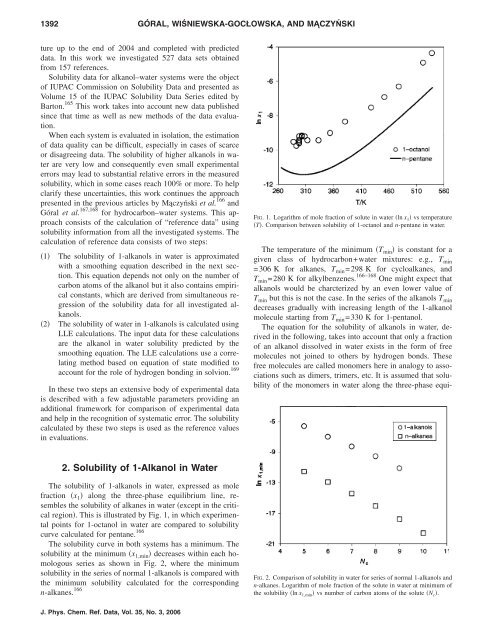Recommended Liquid–Liquid Equilibrium Data. Part 4. 1-Alkanol ...
Recommended Liquid–Liquid Equilibrium Data. Part 4. 1-Alkanol ...
Recommended Liquid–Liquid Equilibrium Data. Part 4. 1-Alkanol ...
Create successful ePaper yourself
Turn your PDF publications into a flip-book with our unique Google optimized e-Paper software.
1392 GÓRAL, WIŚNIEWSKA-GOCŁOWSKA, AND MĄCZYŃSKI<br />
ture up to the end of 2004 and completed with predicted<br />
data. In this work we investigated 527 data sets obtained<br />
from 157 references.<br />
Solubility data for alkanol–water systems were the object<br />
of IUPAC Commission on Solubility <strong>Data</strong> and presented as<br />
Volume 15 of the IUPAC Solubility <strong>Data</strong> Series edited by<br />
Barton. 165 This work takes into account new data published<br />
since that time as well as new methods of the data evaluation.<br />
When each system is evaluated in isolation, the estimation<br />
of data quality can be difficult, especially in cases of scarce<br />
or disagreeing data. The solubility of higher alkanols in water<br />
are very low and consequently even small experimental<br />
errors may lead to substantial relative errors in the measured<br />
solubility, which in some cases reach 100% or more. To help<br />
clarify these uncertainties, this work continues the approach<br />
presented in the previous articles by Mączyński et al. 166 and<br />
Góral et al. 167,168 for hydrocarbon–water systems. This approach<br />
consists of the calculation of “reference data” using<br />
solubility information from all the investigated systems. The<br />
calculation of reference data consists of two steps:<br />
1 The solubility of 1-alkanols in water is approximated<br />
with a smoothing equation described in the next section.<br />
This equation depends not only on the number of<br />
carbon atoms of the alkanol but it also contains empirical<br />
constants, which are derived from simultaneous regression<br />
of the solubility data for all investigated alkanols.<br />
2 The solubility of water in 1-alkanols is calculated using<br />
LLE calculations. The input data for these calculations<br />
are the alkanol in water solubility predicted by the<br />
smoothing equation. The LLE calculations use a correlating<br />
method based on equation of state modified to<br />
account for the role of hydrogen bonding in solvion. 169<br />
In these two steps an extensive body of experimental data<br />
is described with a few adjustable parameters providing an<br />
additional framework for comparison of experimental data<br />
and help in the recognition of systematic error. The solubility<br />
calculated by these two steps is used as the reference values<br />
in evaluations.<br />
2. Solubility of 1-<strong>Alkanol</strong> in Water<br />
The solubility of 1-alkanols in water, expressed as mole<br />
fraction x 1 along the three-phase equilibrium line, resembles<br />
the solubility of alkanes in water except in the critical<br />
region. This is illustrated by Fig. 1, in which experimental<br />
points for 1-octanol in water are compared to solubility<br />
curve calculated for pentane. 166<br />
The solubility curve in both systems has a minimum. The<br />
solubility at the minimum x 1,min decreases within each homologous<br />
series as shown in Fig. 2, where the minimum<br />
solubility in the series of normal 1-alkanols is compared with<br />
the minimum solubility calculated for the corresponding<br />
n-alkanes. 166<br />
J. Phys. Chem. Ref. <strong>Data</strong>, Vol. 35, No. 3, 2006<br />
FIG. 1. Logarithm of mole fraction of solute in water ln x 1 vs temperature<br />
T. Comparison between solubility of 1-octanol and n-pentane in water.<br />
The temperature of the minimum T min is constant for a<br />
given class of hydrocarbon+water mixtures: e.g., T min<br />
=306 K for alkanes, T min=298 K for cycloalkanes, and<br />
T min=280 K for alkylbenzenes. 166–168 One might expect that<br />
alkanols would be charcterized by an even lower value of<br />
T min but this is not the case. In the series of the alkanols T min<br />
decreases gradually with increasing length of the 1-alkanol<br />
molecule starting from T min=330 K for 1-pentanol.<br />
The equation for the solubility of alkanols in water, derived<br />
in the following, takes into account that only a fraction<br />
of an alkanol dissolved in water exists in the form of free<br />
molecules not joined to others by hydrogen bonds. These<br />
free molecules are called monomers here in analogy to associations<br />
such as dimers, trimers, etc. It is assumed that solubility<br />
of the monomers in water along the three-phase equi-<br />
FIG. 2. Comparison of solubility in water for series of normal 1-alkanols and<br />
n-alkanes. Logarithm of mole fraction of the solute in water at minimum of<br />
the solubility ln x 1,min vs number of carbon atoms of the solute N c.
















